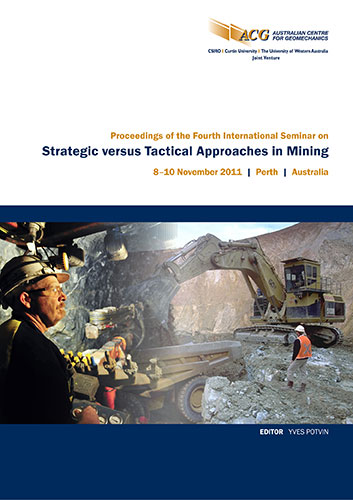Commercialisation of rangeland carbon offsets by resource companies

|
Authors: Alchin, M; Braimbridge, M; Jasper, D; Hay, B; Lacy, H Paper is not available for download Contact Us |
DOI https://doi.org/10.36487/ACG_rep/1108_16_Alchin
Cite As:
Alchin, M, Braimbridge, M, Jasper, D, Hay, B & Lacy, H 2011, 'Commercialisation of rangeland carbon offsets by resource companies', in Y Potvin (ed.), Strategic versus Tactical 2011: Proceedings of the Fourth International Seminar on Strategic versus Tactical Approaches in Mining, Australian Centre for Geomechanics, Perth, pp. 205-210, https://doi.org/10.36487/ACG_rep/1108_16_Alchin
Abstract:
Resource companies have an opportunity to make a major contribution to the rehabilitation of the Australian rangelands through the commercialisation of carbon offsets. Development of carbon offset projects in the rangelands could have a tangible impact on the legacy load of greenhouse gas emissions and thereby mitigate the potential adverse effects of climate change. Carbon offset projects implemented by resource companies can also deliver significant socio-economic and environmental co-benefits in regional and remote Australia. The CSIRO conservatively estimates that offsets generated by rehabilitation and reforestation of Australia’s overgrazed rangelands and the implementation of controlled savanna burning would be equivalent to the abatement of approximately 19% of Australia’s total greenhouse gas emissions (CSIRO, 2009). The carbon offsets created by these activities in the Australian rangelands could generate in excess of AU$ 2.2 billion per annum. This revenue would continue to be generated until the maximum sequestration potential of the rangelands is reached (i.e. the condition of the land reaches its climax ecological state). A carbon offset represents a reduction in greenhouse gases, or enhancement of greenhouse gas removal from the atmosphere by sinks, relative to a ‘business-as-usual’ baseline. Carbon offsets are tradeable and often used to negate (offset) all or part of a company’s emissions. To be eligible as an offset, they must fulfil certain criteria, including: additionality, measurability, transparency, permanency, ownership and verifiability. It is possible that Australia will adopt some form of mandatory carbon pricing in the future. Hence, there is a growing impetus for resource companies to implement sustainability strategies which can adapt to the financial liabilities associated with carbon pricing. Many resource companies control large tracts of land, typically to maintain access to their project area/s. The commercial benefit of owning or leasing this land could be enhanced if it was used to establish a carbon offset project. The credits created by the offset project could partially or completely offset the emissions produced by the resource operations. If Australia adopts a carbon tax it is possible that the offset credits could be used to obtain a rebate on any financial liability the resource company may incur. This paper briefly outlines the strategic opportunity for resource companies to capitalise on their existing land assets and potentially derive significant benefits for their shareholders, relevant stakeholders and the environment. It provides some specific examples of eligible carbon offset management options in the rangelands. Finally, the paper discusses the opportunities and major risks associated with the commercialisation of carbon offsets in the Australian rangelands.
References:
Adams, M., Grierson, P., Bussau, A. and Dorling, K. (2001) Biomass and carbon in vegetation of the Pilbara region, Western Australia, Final report submitted to Hamersley Iron, BHP and Robe, July 2001, Ecosystems Research Group, The University of Western Australia, Crawley.
Alchin, M., Tierney, E. and Chilcott, C. (2010) Carbon Capture Project - Final Report, An evaluation of the opportunity and risks of carbon offset based enterprises in the Kimberley-Pilbara region of Western Australia, Department of Agriculture and Food Western Australia, Kununurra.
Cook, G., Liedloff, A., Eager, R., Chen, X., Williams, R., Grady, A. and Hutley, L. (2005) The estimation of carbon budgets of frequently burnt tree stands in savannas of northern Australia, using allometric analysis and isotopic discrimination, Australian Journal of Botany, Vol. 53, pp. 621–630.
CSIRO (2009) An analysis of greenhouse gas mitigation and carbon biosequestration opportunities from rural land use, National Research Flagships - Sustainable Agriculture, CSIRO Livestock Industries, Armidale.
Curry, P., Payne, A., Leighton, K., Hennig, P. and Blood, D. (1994) Technical Bulletin No. 84 - An inventory and condition survey of the Murchison River catchment and surrounds, Western Australia, Department of Agriculture Western Australia, Perth.
DCCEE (2011) Department of Climate Change and Energy Efficiency. Think Change, viewed 31 May 2011, .
Department of Climate Change (2009) Australian National Greenhouse Accounts – State and Territory greenhouse gas inventories 2007, Commonwealth Government, Canberra.
Derner, J. and Schuman, G. (2007) Carbon sequestration and rangelands: A synthesis of land management and precipitation effects, Journal of Soil and Water Conservation, Vol. 62, No. 2, pp. 77–85.
Garnaut, R. (2011) The Garnaut Review 2011 – Australia in the Global Response to Climate Change, Cambridge University Press, Port Melbourne.
Payne, A., Van Vreeswyk, S., Pringle, H., Leighton, K. and Hennig, P. (1998) Technical Bulletin 90, An inventory and condition of survey of the Sandstone-Yalgoo-Paynes Find area, Western Australia, Agriculture Western Australia, Perth.
Pringle, H. and Tinley, K. (2001) Ecological sustainability for pastoral management, Journal of Agriculture Western Australia, Vol. 42, pp. 30–35.
Rangelands Australia (2011) Rangelands Australia, C/o University of Queensland, Gatton, Australia, viewed 31 May 2011, .
Wilcox, D. and McKinnon, E. (1974) A report on the condition of the Gascoyne catchment, Western Australia, Department of Agriculture, Perth.
Yamada, K., Kojima, T., Abe, Y., Williams, A. and Law, J. (1999), Carbon sequestration in an arid environment near Leonora, Western Australia, Journal of Arid Land Studies, Vol. 9, No. 2, pp. 143–151.
© Copyright 2025, Australian Centre for Geomechanics (ACG), The University of Western Australia. All rights reserved.
View copyright/legal information
Please direct any queries or error reports to repository-acg@uwa.edu.au
View copyright/legal information
Please direct any queries or error reports to repository-acg@uwa.edu.au